Even knives marked “Stainless” can have unsafe levels of bioavailable Lead (especially if the handle is made of a different material). Read more here.
This is an ad-free article.
We are publishing this article as ad-free to make it easier for you to read. If you would like to support our independent consumer goods testing by contributing (which will also help us keep our more widely-read articles ad-free!), click here. Thank you!
For more ways to contribute & support this work, click here.
For those new to the Lead Safe Mama website:
Tamara Rubin is a multiple-federal-award-winning independent advocate for childhood Lead poisoning prevention and consumer goods safety, and a documentary filmmaker. She is also a mother of Lead-poisoned children (two of her sons were acutely Lead-poisoned in 2005).
- Tamara owns and runs Lead Safe Mama, LLC — a community collaborative woman-owned small business for childhood Lead poisoning prevention and consumer goods safety.
- Since 2009, Tamara has been using XRF technology (a scientific testing method) using the exact instrumentation employed by the U.S. Consumer Product Safety Commission to test consumer goods for toxicants (specifically heavy metals — including Lead, Cadmium, Mercury, Antimony, and Arsenic).
- Since July of 2022, the work of Lead Safe Mama, LLC has been responsible for 5 product recalls (FDA and CPSC).
- All test results reported on this website are science-based, accurate, and replicable.
- Items that Lead Safe Mama, LLC reports on are tested multiple times to confirm the results published (for each component tested).
- Tamara’s work was featured in Consumer Reports Magazine in February 2023 (March 2023 print edition) and The Guardian in November 2023.
Published: December 26, 2023
Tuesday
As background for each of these articles, I wanted readers to have the the following context:
- All U.S. federal agencies agree that there is no safe level of Lead exposure for human beings.
- There is currently no federal regulatory limit for total Lead content in most consumer goods — UNLESS they are items explicitly “intended for use by children.”
- Officially, dishware and kitchenware are not considered to be “items intended for use by children” (!) — consequently, there is currently no regulatory limit for total Lead content, as detectable by an XRF instrument, in these items. (!)
- LEAD: For context, according to U.S. federal regulations, any item made specifically “for use by children” must not test positive for Lead at levels above 90 ppm Lead in the paint, glaze, or coating and also must not test positive for Lead at levels above 100 ppm Lead in the substrate (base material).
- The instrumentation Lead Safe Mama, LLC uses is the same instrumentation used by the United States Consumer Product Safety Commission to screen consumer goods for toxicants (including Lead, Cadmium, Mercury, Antimony, Arsenic, etc.)
- There is no current U.S. federal regulation specifying any total Cadmium-content limit for most consumer goods.
- CADMIUM: The two current strictest regulatory standards for Cadmium content are the State of Washington’s regulatory limit (40 ppm, total content), and the Country of Demark’s total limit (75 ppm total content).
- Any item that tests below 90 ppm Lead in all components is considered (by Lead Safe Mama, LLC) “safe by all standards.”
- Any item that tests below 40 ppm Cadmium in all components is considered (by Lead Safe Mama, LLC) “safe by all standards.”
- We present this information to you (Lead Safe Mama readership, and our greater community) so you can make informed decisions about using products you already own or may be evaluating for purchase.
- For greater context about the “WHY” behind what we do here, click here.
- To learn more about sending an item in to Lead Safe Mama, LLC for testing (as part of the collaborative work we do with our community), click here.
- To read more about the testing methodology Lead Safe Mama, LLC uses, click here.
- To read more about Lead Safe Mama, LLC’s business model, click here.
- To make a contribution in support of the work of Lead Safe Mama, LLC (or to support our work in other ways), click here.
Brief Summary Regarding the Knife Pictured
The knife pictured is a “sterling silver” knife. While the object is technically silver, the actual silver content of the handle is significantly below 92.5% — the level at which modern silver is officially considered to be “Sterling Silver.” (This knife is about 77% silver.) As with most dinner knives, the blade is (as marked) made of stainless steel (a low-nickel variant of the metal, as demonstrated by the XRF test results shown below).
The problem:
When you have a dinner knife made of multiple types of metals (and specifically an older vintage or antique dinner knife manufactured before the year 2000) it is often the case that the two different types of metals (or other disparate materials) have been joined together with either a chunk of Lead (a decorative detail made of Lead to hold the two pieces together) or with a Lead-based solder to help the two different materials (the stainless and the silver) “stick” together. In this case, as you can clearly see in the second image above, it looks like a Leaded solder was used. This is typical for older knives like this and especially typical for Silver knives with stainless blades.
This is a significant problem because, while the XRF reading of this particular knife “only” came in at 3,758 ppm Lead (already an alarming number for Lead-content in a food-contact utensil), the reading is artificially low given the fact that the reading also included some part of the silver handle and some parts of the Stainless blade. What this means is that the ACTUAL Lead level of the solder point/ join point of this knife is likely much, much higher. I expect if I were to test the solder of this knife separately from the knife (which requires destructive testing) it would likely test positive for between 600,000 and 900,000 ppm Lead, depending on the actual age of the knife (which is unknown).
Given how the user holds a knife when eating, there is a distinct and likely possibility that the Lead from this join point would be transferred onto the hands of the user during the course of a meal, potentially resulting in hand-to-mouth activity (that one might expect while eating dinner, as one does). This could cause ingestion of microparticulate Lead that was transferred to the hands by using the knife. It is for this reason knives like this are potentially VERY unsafe and should not be used. Is this an actual poisoning risk though? Read more about that here.
The solution:
- Modern solid stainless knives (with no join point differentiating the handle from the blade) are fairly common today and are typically Lead free.
- These safer knives can easily be found inexpensively at Target, Walmart, Ikea and other vendors.
- To determine if your dinner knives are safe (from a Lead perspective), just carefully inspect the place where the metal of the blade connects with the metal of the handle to make sure it is the same material and — ideally — there is no seam that might be made of a different material (a material which is visually a slightly different color or finish — like dull gray vs. shiny silver — as shown above or in this article).
- NOTE: Stainless knives with stainless blades and stainless handles sometimes do have a seam joining the knife to the handle, but it is not normally a seam with a different metal in between — it is, more often than not, an intentional decorative element of the knife (where the thin part of the blade connects to the thicker part of the handle) vs. a relic of the manufacturing process (like the Lead added in the knife in this article).
- The issue of the concern for Lead in dinner knives is generally ONLY a concern with knives, and is not also a concern with spoons and forks (forks and spoons are generally fabricated with the same material making up the handle and the food-end of the utensil, and no join point).
- ANY brand and ANY design of modern (sold today) ALL STAINLESS STEEL silverware should be safe (from a toxicant concern). More specifically, these modern all-stainless options (post-2000) should test negative for Lead, Cadmium, Mercury, Arsenic, and Antimony when tested using XRF technology.
- Modern stainless steel items may come with a Prop 65 warning (for Nickel and Chromium), but those metals are not generally concerning in silverware given silverware’s use and application (when used as intended). You can read more about that here.
- Some additional purchasing tips (if you want to be extra cautious):
- Avoid vintage silverware
- Avoid antique silverware
- Avoid silverware with plastic handles
- Avoid silverware with wood handles
- Avoid all-plastic silverware
- Avoid silverware with silicone components
- Avoid items sold as “Pewter” (even “Lead-Free Pewter”)
- Avoid lacquered wood flatware
- Avoid painted wood flatware
- Note (tangentially relevant): The issue of Lead in join points of multi-component food-use items can also be present on sterling silver baby cups (and other sterling silver items that may have different components soldered together). I don’t have a sterling silver baby cup example up on the website right now, but this Moscow Mule mug has the same concern (different metals, stuck together with a hunk of bioavailable Lead).
Can I Test These Myself at Home?
Given the fact that the join point on some of this silverware is actually solid Lead (or close to solid Lead)… they may actually test positive with a home test kit (even though the home test kits are designed for testing for Lead in paint, not for testing for Lead in consumer goods). If you want to buy a home test kit, this is the one we recommend (linked here) — PLEASE watch the video in this article to see how they work and how to differentiate a false positive from a true positive. The Chinese knock-offs of these home test kits DO NOT WORK and are a waste of money because they give false positives and false negatives on many things! You can read more about that here.
Some additional reading that may be of interest:
- More knives we have tested.
- More Lead-contamianted knives we have tested.
- The silverware category of articles on this website.
XRF test results for the “Stainless Steel” dinner knife pictured here.
Reading #1) The Stainless Steel of the blade on the knife
Stainless Steel #410/16
- Lead (Pb): non-detect
- Cadmium (Cd): non-detect
- Mercury (Hg): non-detect
- Arsenic (As): non-detect
- Antimony (Sb): non-detect
- Vanadium (V): 1,311 +/- 358 ppm
- Chromium (Cr): 133,600 +/- 1,400 ppm
- Manganese (Mn): 5,292 +/- 1,052 ppm
- Iron (Fe): 853,900 +/- 2,400 ppm
- Nickel (Ni): 1,773 +/- 425 ppm
Reading #2) The metal of the handle on the knife
Low-quality sterling silver (not 925 grade, possibly made before 1920)
- Lead (Pb): non-detect
- Cadmium (Cd): non-detect
- Mercury (Hg): non-detect
- Arsenic (As): non-detect
- Antimony (Sb): non-detect
- Nickel (Ni): 51,000 +/- 2,400 ppm
- Copper (Cu): 157,500 +/- 3,300 ppm
- Zinc (Zn): 17,100 +/- 1,200 ppm
- Molybdenum (Mo): 728 +/- 183 ppm
- Silver (Ag): 771,100 +/- 8,800 ppm (about 77% Silver)
Reading #3) The “Join Point” (the seam) between the handle and the blade of the knife
- Lead (Pb): 3,758 +/- 322 ppm
- Cadmium (Cd): non-detect
- Mercury (Hg): non-detect
- Arsenic (As): non-detect
- Antimony (Sb): non-detect
- Vanadium (V): 1,464 +/- 683 ppm
- Chromium (Cr): 151,500 +/- 2,200 ppm
- Manganese (Mn): 4,891 +/- 1,481 ppm
- Iron (Fe): 700,800 (70%)
Tamara Elise Rubin
Owner — Lead Safe Mama, LLC
~ End ~
Never Miss an Important Article Again!
Join our Email List


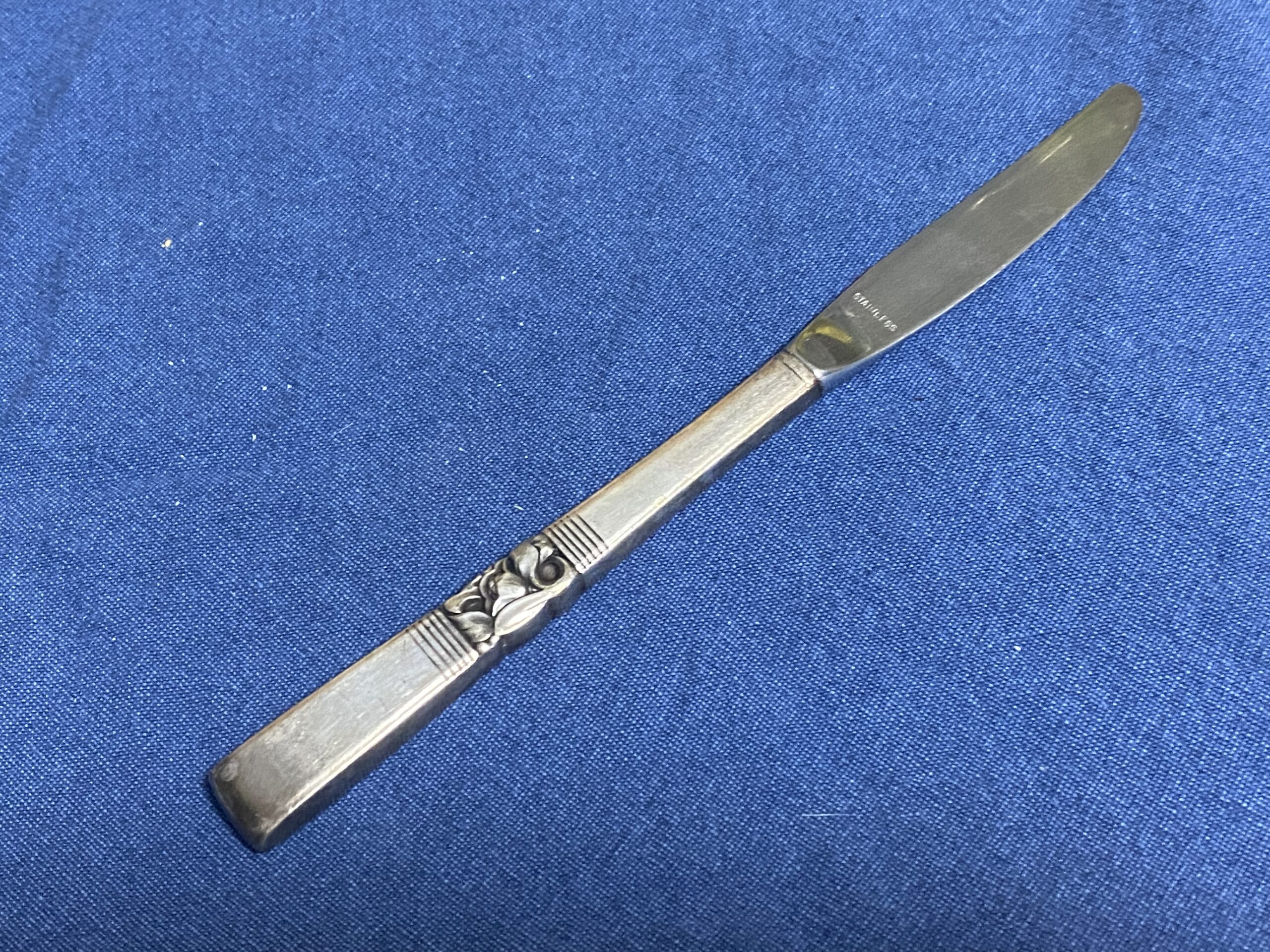
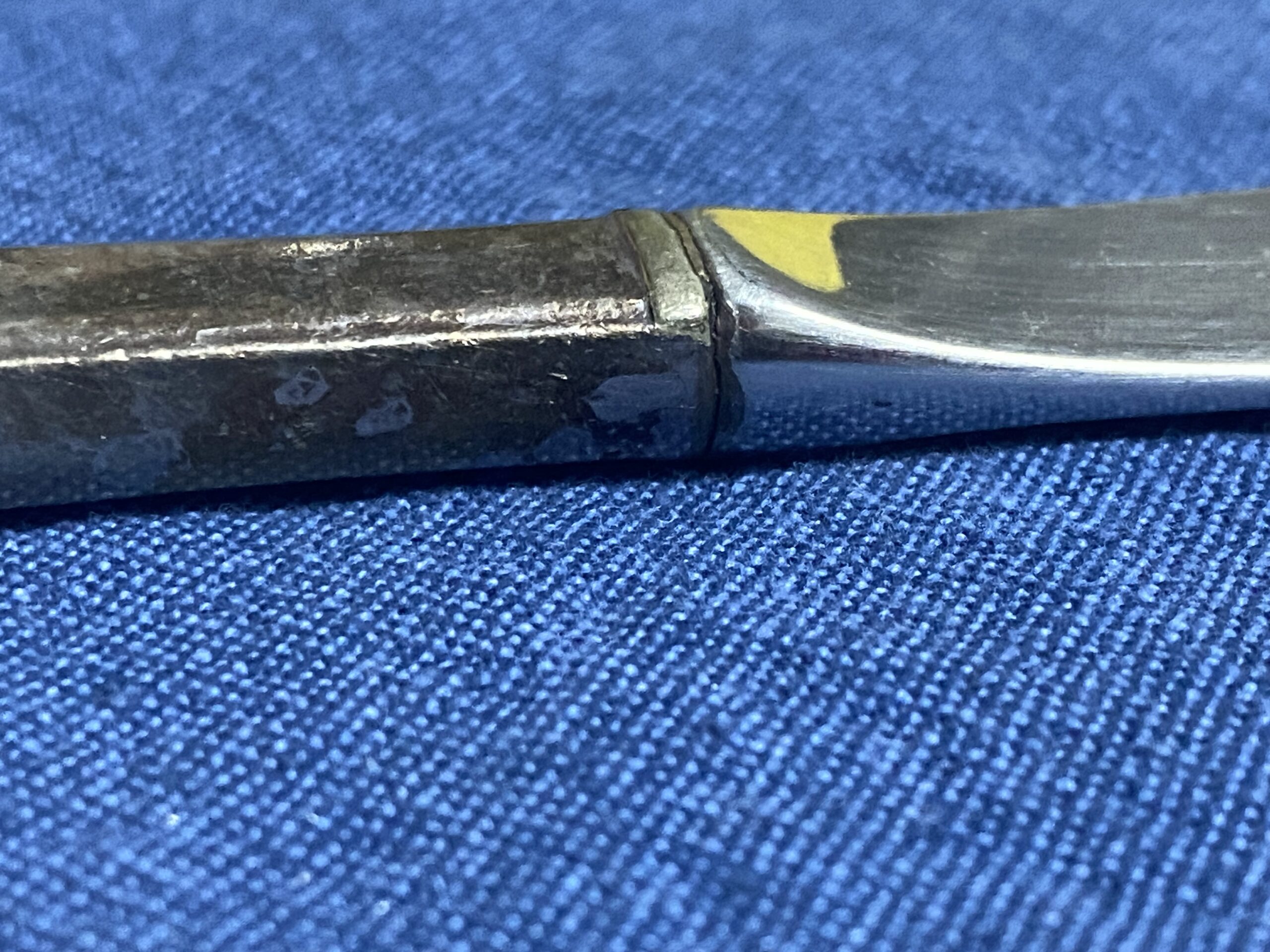






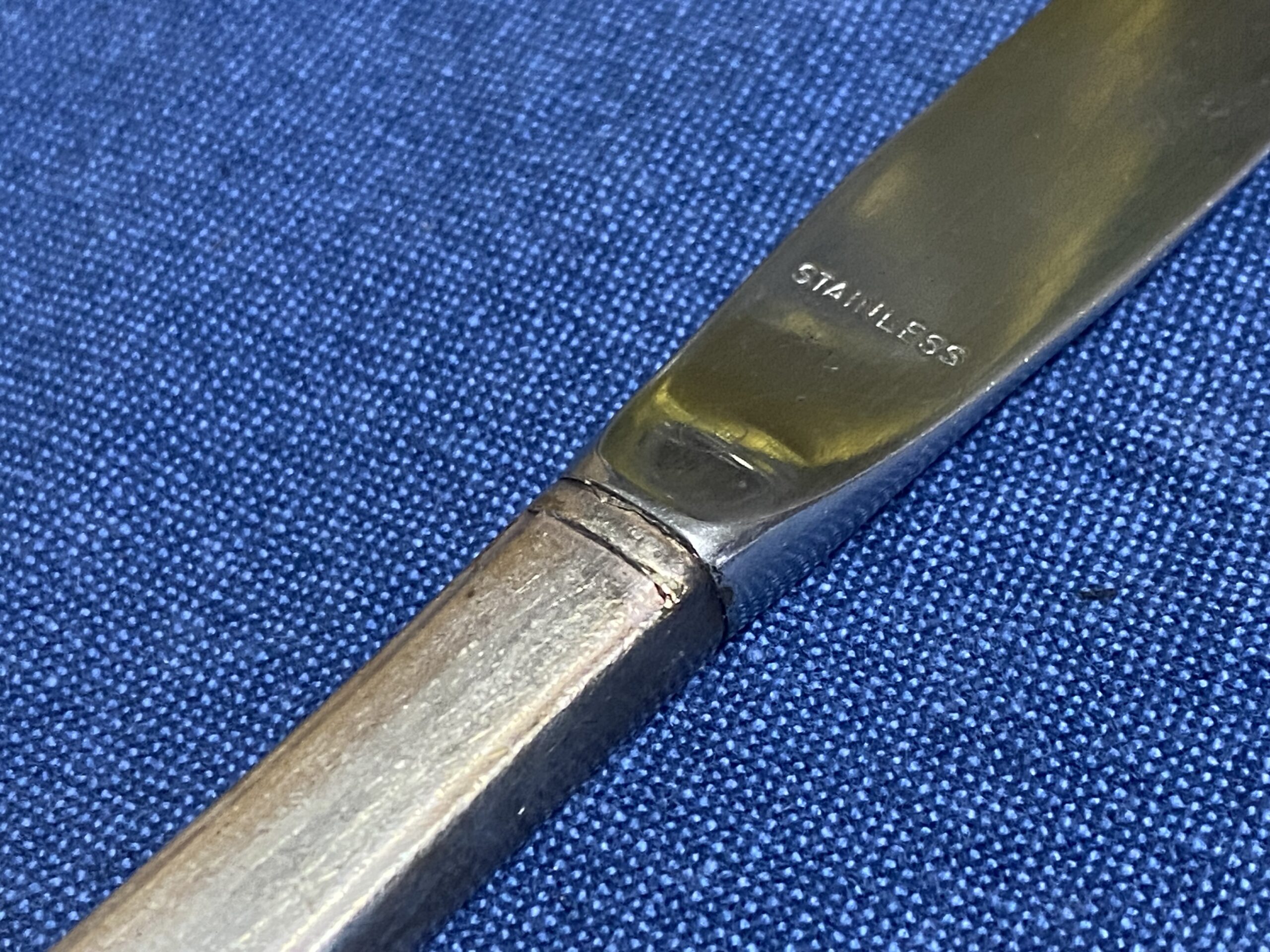
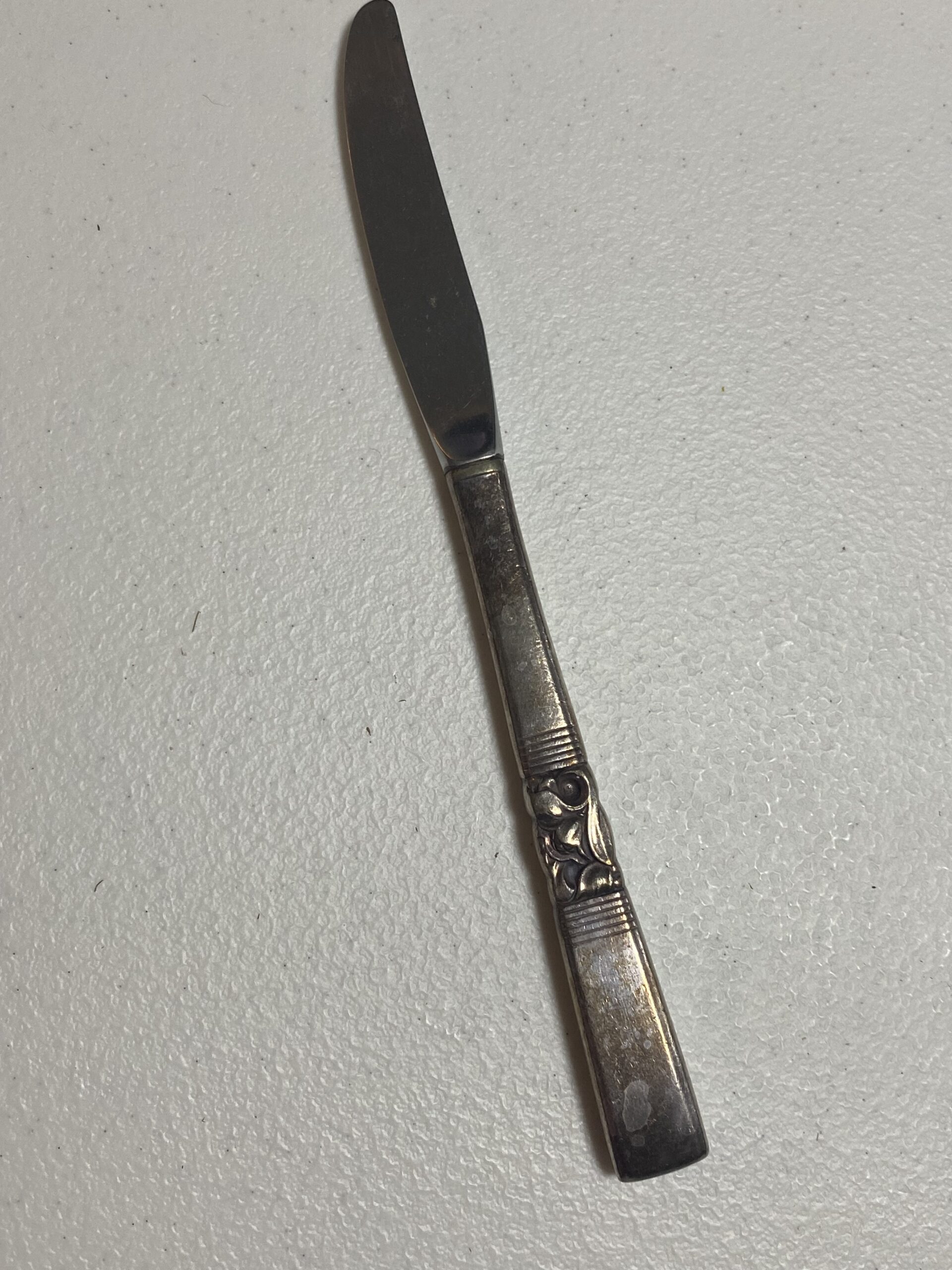
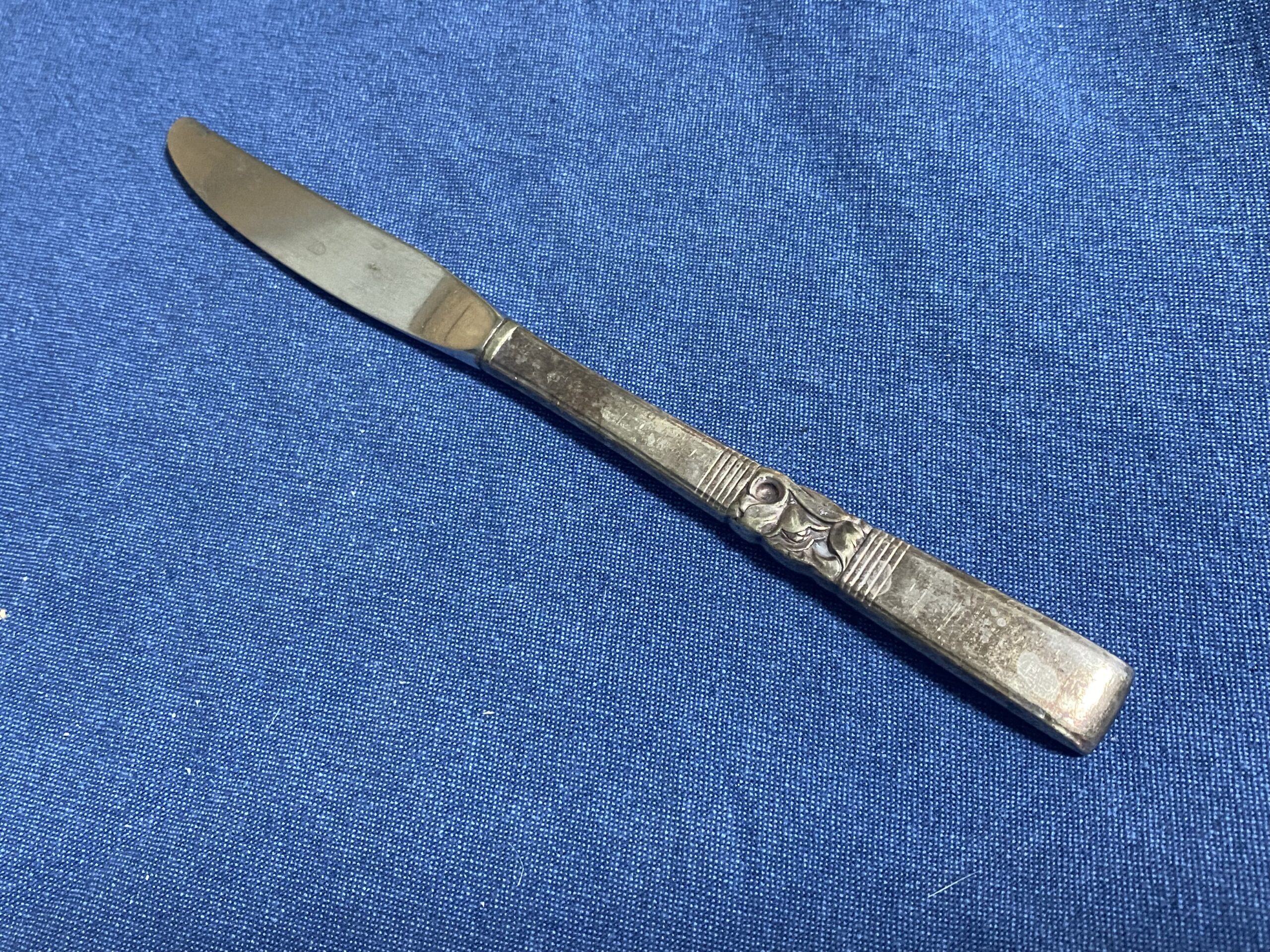
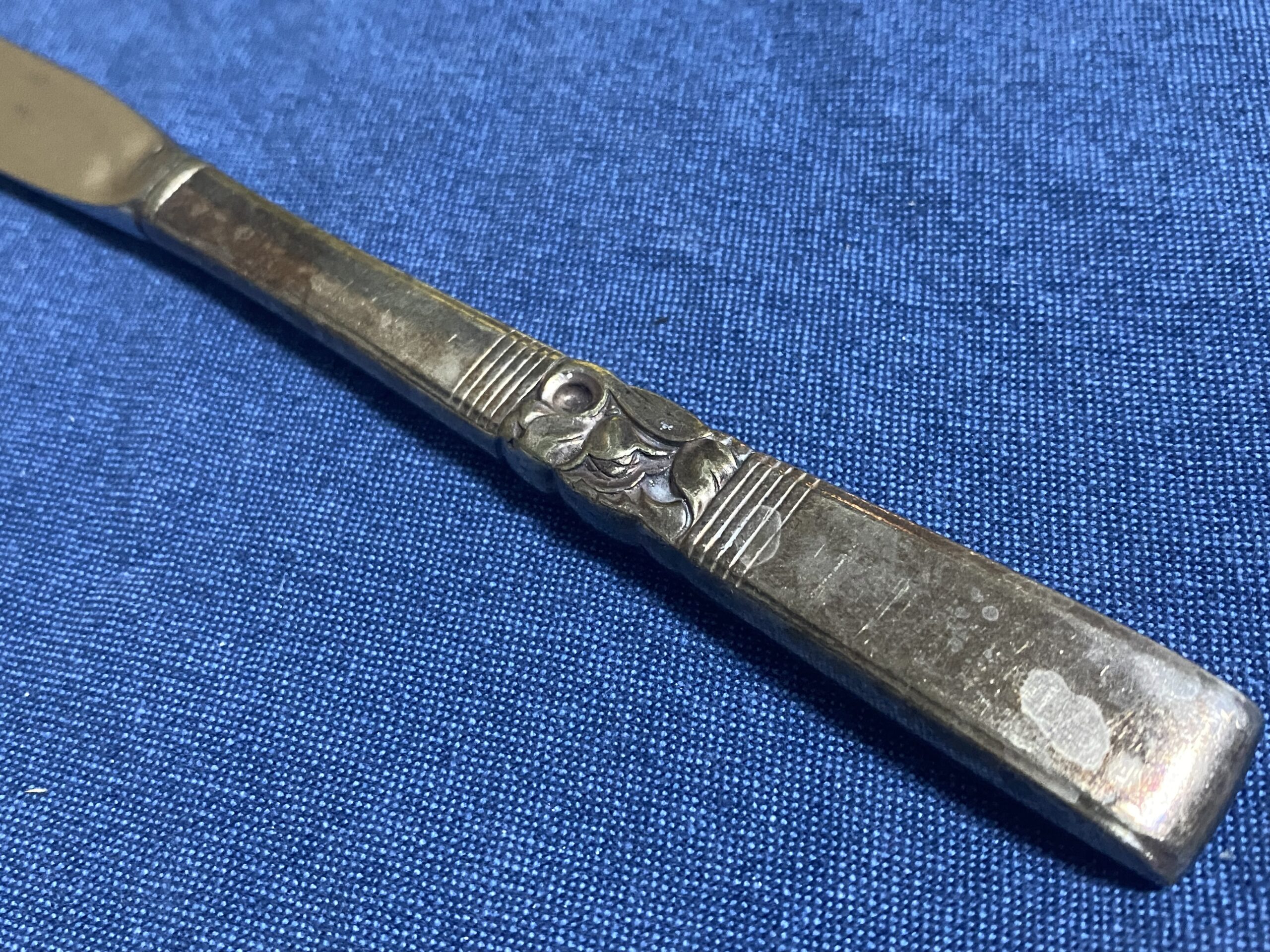
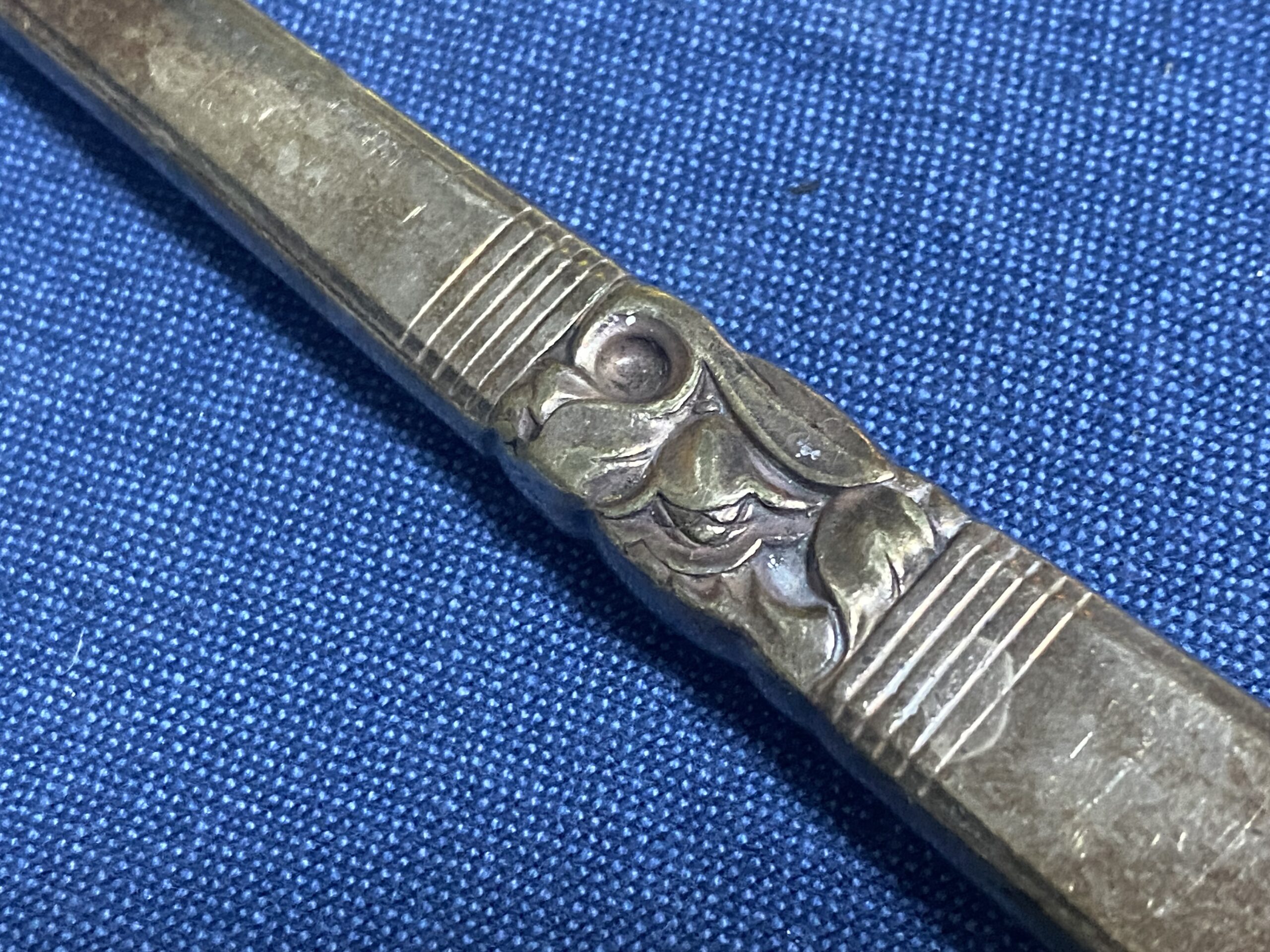
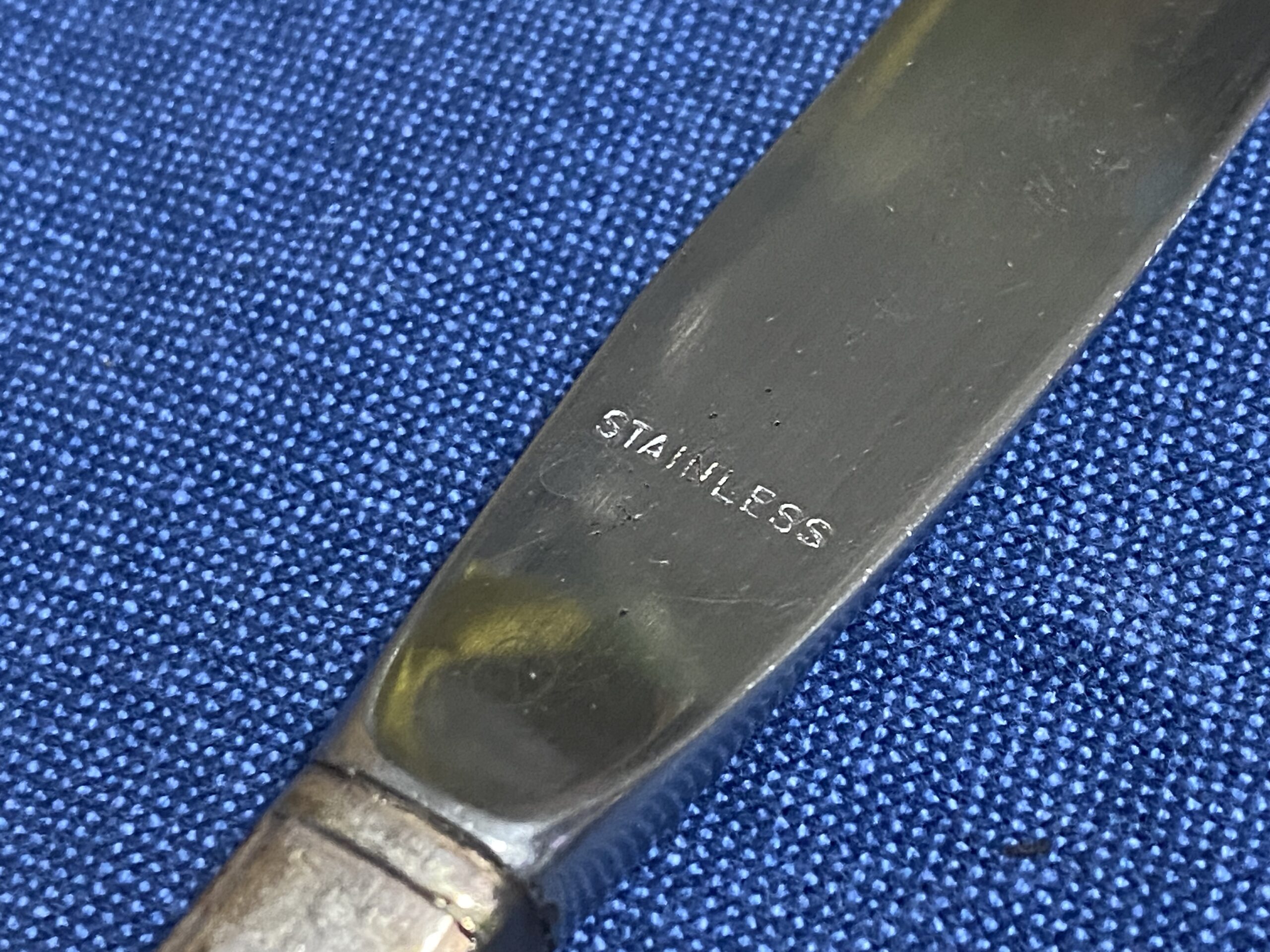

Why no silverware with wooden handles?
Hi, Tell me more about Pewter. We have a pitcher from Denmark and we have pewter serving spoons and forks handmade by Kenneth Lundy, a Yale artist- craftsman.
Search for pewter on her search bar. Pewter is highly leaded.
Fascinating. Ironically, I have an old spoon of the same pattern (that we don’t use – it was just something that was in my mother’s kitchen drawer, for reasons unknown).
I do have a stainless steel steak knife (Ekco company, made in Taiwan) with a hard plastic handle. I don’t see any metal joint. Is that a concern?
Are (completely) stainless steel flatware from the 50s or 70s or later safe?
Thank you for this article on antique silverware. I have my great-grandmother and grandmother’s silverware that looks similar to it. I think it will go to the family musuem to be looked at and nothing else.
Hi Tamara, Thank you for everything you are doing, here!
We have a set of mid-century modern Stainless Steel (18/8) Lauffer Magnum Norway flatware designed by Don Wallance. The knives have what seems to be a decorative line between handle and blade that looks likely NOT to have been soldered on (but appears to be purely decorative as you mentioned above is possible, though not in your silver handled/stainless blade example).
However, it is also clear that the handles of our Lauffer Magnum Norway 18/8 knives are hollow (one of the knives has something loose rattling around within the hollow handle to confirm this).
Does this undermine my sense that the line between the blade and handle is only decorative (i.e. does it seem likely to you that hollow stainless handles have to be soldered onto a solid stainless blade, despite them both being made up of the same high quality, Low nickel 18/8 stainless steel?).
I bow to your understanding of how these things are manufactured? I cannot see any visible difference in metal between the two parts — they appear seamless and the “line” seems decorative — yet I may be kidding myself because it is clear that the handle is hollow??
Any thoughts you might have would be so gratefully received.
Best wishes,
Laura